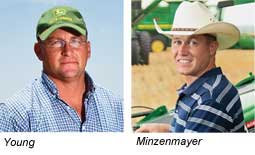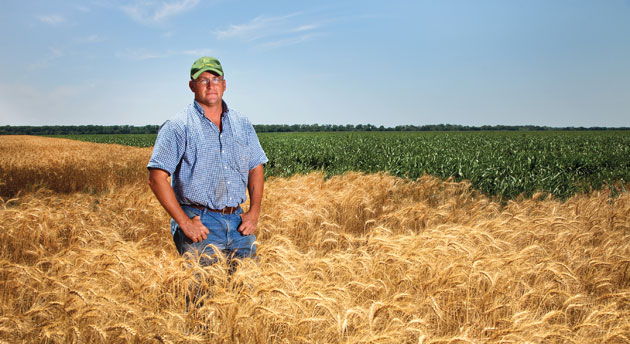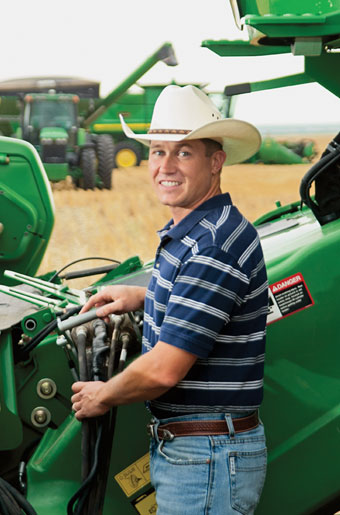FARM MANAGEMENT

With a name like Young, it seems natural that Justin and Shanda Young were named Texas Farm Bureau’s Outstanding Young Farmer and Rancher for 2011.
Paul and Monica Minzenmayer earned the same Texas award in 2010. A year later, the American Farm Bureau Federation presented them with the national Young Farmers and Ranchers Achievement Award in 2011. Farm Credit sponsors the Farm Bureau’s Young Farmer and Rancher programs, which recognize the accomplishments of top producers age 35 and under.
Landscapes asked these two young Farm Credit customers to share their advice with other beginning farmers and ranchers on how to succeed in production agriculture.
Young Producers Share Tips for Success
1. Move away and get an education.
Minzenmayer’s goal in college was to learn how big corporations operate. “I knew how to manage crops,” he says. “I wanted to learn about how to handle the numbers.” Young’s parents encouraged him to attend college. “Getting away gave me the chance to learn how to survive on my own,” he says.
2. Set goals.
“Visualize where you’re going to be in 10 years, and don’t let anybody tell you that you can’t get there,” Young says.
3. Take a calculated risk.
Young suggested that his family raise chicken broilers a few years ago when fertilizer prices skyrocketed. “Our growing operation required more fertilizer, and chicken litter meets almost all of our needs,” he explains. Plus, the broilers generate additional income.
4. Diversify.
Young partnered with his dad to invest in an office building and a convenience store with a Subway restaurant. “You have to diversify to keep your operation strong during hard times,” Young says. “These businesses provide year-round cash flow.”
5. Learn how to market.
When Minzenmayer needed more grain storage in 2008, he invested in Lone Star Grain Elevator. The elevator gives him additional options for marketing and hedging crops. He doesn’t wait to make a huge profit before selling. “As long as you sell for a profit, you’ll never go broke,” he says.
6. Plan for tough times.
While many Texas livestock producers were forced to sell cattle due to a lack of feed and grass during the 2011 drought, both young producers were able to grow what they needed. When corn failed to mature, the Youngs chopped it into silage. Minzenmayer kept moving his cattle to the best grass and water available.
7. Spend conservatively.
The Young family grows its operation through sweat equity. “Compared with most large operations, we do more with less equipment and less help,” Young says. When Minzenmayer started out, he traded his labor for the use of other farmers’ equipment. He purchased machinery from his dad and bought additional machinery from other retiring farmers, which led to leasing the farmers’ lands. “Whenever we buy something new, I make sure it pays off,” Minzenmayer says. “You won’t find a lot of toys on this farm.”
8. Take care of the land.
Minzenmayer started out growing cotton, but now rotates cotton with no-till wheat. Rotating reduces insects and weeds, and he has seen a tremendous increase in cotton production. “Cotton takes a lot out of the ground,” he says. “Wheat puts it back.”
9. Don’t bite off more than you can chew.
Minzenmayer continues to lease much of his acreage. “The more we take care of our landlords, the more land comes our way,” he says. “We do what we say we’re going to do, and our landlords tell their friends. Don’t buy land before your balance sheet can afford it.”
10. Keep Growing.
The Youngs pour most earnings into expanding their operation. “We purchase land as a family,” Young says. “We can buy more that way.” For Minzenmayer, getting bigger makes sense because he can spread equipment and other expenses over more acres, lowering per-acre costs.
11. Manage your time by building a strong team.
Young earned a degree in diesel mechanics, but calls on experts for major repairs. A friend manages the Subway and convenience store. “I focus my time on where it adds the most value,” Young says. Minzenmayer spends two days a week in his office handling accounting for the farm and elevator. He depends on employees to handle day-to-day tasks. “They know what to do,” he says.
12. Don’t sweat the small stuff.
“When you work with family, you’ve got to sweep the little stuff under the rug,” Young says. “As long as everyone respects one another, it works.” The same holds true for employees. “Everybody has their own way of doing things,” Minzenmayer says. “Pick your battles carefully.”
13. Embrace challenges.
“You’ve got to know how to do a little bit of everything on a farm,” Young says.
14. Take time off.
Minzenmayer and his employees don’t work on Sundays. “It took me awhile to get there,” he admits. “But we get so much more done during the week now — even during harvest.” Both Minzenmayer and Young enjoy boating on nearby lakes on weekends. “That’s where I clear my mind and get ready to go again,” Young says.
15. Join young farmer groups.
Through the Texas Farm Bureau’s two-year Ag Lead program, Young and his wife, Shanda, visited Washington, D.C., California, Canada and areas of Texas. Paul and Monica Minzenmayer traveled with Farm Bureau, too. “I’d recommend the program to anyone who wants to be a better leader,” Young says. “It opened my eyes to what’s going on around the world.” As a bonus, both couples remain friends with others they’ve met through Ag Lead.
16. Love what you do.
As Young says, “When you’re doing what you love, it’s more than just a job.”
Justin Young
Partners With Family

Justin Young
Photo by Jim Lincoln
Justin Young owes a big part of his success to working closely with family members. He partners with his father, Paul, his uncle David and his cousin Kevin in a farming and ranching operation in the Waco area. Another partner, his aunt, Robin Thomas, handles accounting.
The older generation, including Justin’s grandparents Henrietta and Maurice Young, welcomed Justin and Kevin as equal partners. “A lot of families aren’t willing to give a young person the right to a leadership position,” Justin says. “My dad and granddad turned over a lot of decision-making. That works better for everybody.”
Justin and his wife, Shanda, and their daughter, Addison, 4, live near Lott, Texas. Shanda commutes to a full-time job in Waco, 40 miles away.
The Young family raises beef cattle, cotton, corn, milo, wheat, oats, soybeans, pecans and hay. The operation is split into three locations around Waco. Justin makes most of the decisions on the farm near his home, which includes 12 broiler chicken houses. But the family makes big decisions together.
Justin recently completed a term as president of the Falls County Farm Bureau, and chairs the district Farm Bureau Young Farmer and Rancher Program.
Texas Land Bank, ACA, has financed the Young family farm for decades, and finances Justin and Shanda’s rural home, too. “The Youngs are the hardest working bunch of people I know, and it’s a pleasure dealing with them,” says Aaron Nors, credit office president in Waco. “Justin has an amazing database of information in his head on every field.” Justin’s father, Paul, is a Texas Land Bank director.
Paul Minzenmayer
Succeeds on His Own

Paul Minzenmayer
Photo by Jim Bean
Paul Minzenmayer grew up on a family farm and struck out on his own at age 17. Today, he and his wife, Monica, a former teacher, operate High Cotton Farms near Rowena, Texas. They have two children, Matt, 5, and Lizzie, 4.
Paul’s relationship with Farm Bureau’s Ag Lead program took him across North America and to South Africa. “It opened my mind to the need for public relations in agriculture,” he says. “I didn’t realize how much people want to know about how we farm. I view it as my duty to be the face of agriculture.”
High Cotton Farms grows cotton, but three-quarters of the acreage is devoted to wheat. The place is also home to about 150 cow-calf pairs.
Paul earned his master’s degree in business administration at Angelo State University. He then spent two years working for a large accounting firm in Midland, driving two hours each way to farm on weekends and becoming a certified public accountant during the same period. Today, he works full time for himself and owns Lone Star Grain Elevator in Roscoe, Texas, with a partner.
Paul served on the Texas Farm Bureau’s Young Farmer and Rancher Advisory Committee. He now serves on the Farm Bureau’s state Wheat Advisory Committee and on the Runnels County board.
Capital Farm Credit, ACA, has financed three of Paul’s land purchases and provides the elevator’s operating loan. “I really like having a CPA for a customer!” says Leon Langley, vice president of Capital Farm Credit in San Angelo. “Paul’s one of the sharpest young men I’ve run across in some time.”
– Nancy Jorgenson
Farm Credit Can Help
Farm Credit recognizes the need to attract young people into farming and ranching. Many Farm Credit associations offer special programs for young and beginning producers.
The numbers for 2010, the latest year for which figures are available, show how Farm Credit has stepped up its commitment nationwide to farmers 35 or younger.
| Young Farmers | 2009 | 2010 |
| No. of Loans Made in Year | 50,689 | 53,470 |
| Loan Volume at Year End | $20.4 billion | $21.1 billion |
In 2010, loans to young farmers represented 16.2 percent of all Farm Credit loans made during the year, and 11.4 percent of the dollar volume of all loans made. The average loan made to young farmers was $136,917, up 4.6 percent from 2009.
Farm Credit also has increased lending to beginning farmers, defined as those with 10 years or less of experience.
| Beginning Farmers | 2009 | 2010 |
| No. of Loans Made in Year | 61,387 | 65,653 |
| Loan Volume at Year End | $34.1 billion | $34.3 billion |
In 2010, loans to beginning farmers represented 19.9 percent of all loans made by Farm Credit during the year, and 16.0 percent of the dollar volume of loans made. The average loan made to beginning farmers was $156,557, up 1.5 percent from 2009.
About Young Farmers
The USDA Census of Agriculture, last taken in 2007, reveals a few facts about producers of different ages:
- The average age of U.S. principal farm operators was 57 in 2007.
- New Mexico, Arizona, Texas, Mississippi and Oklahoma have the highest percentage of older principal operators.
- Across the U.S., only 54,147 farm operators are under age 25; most are between 45 and 65.
- Operators under 45 are twice as likely to have a job off the farm as those over 65.
- Fifty-nine percent of farmers under 45 own all their land, compared with 77 percent of those over 65.